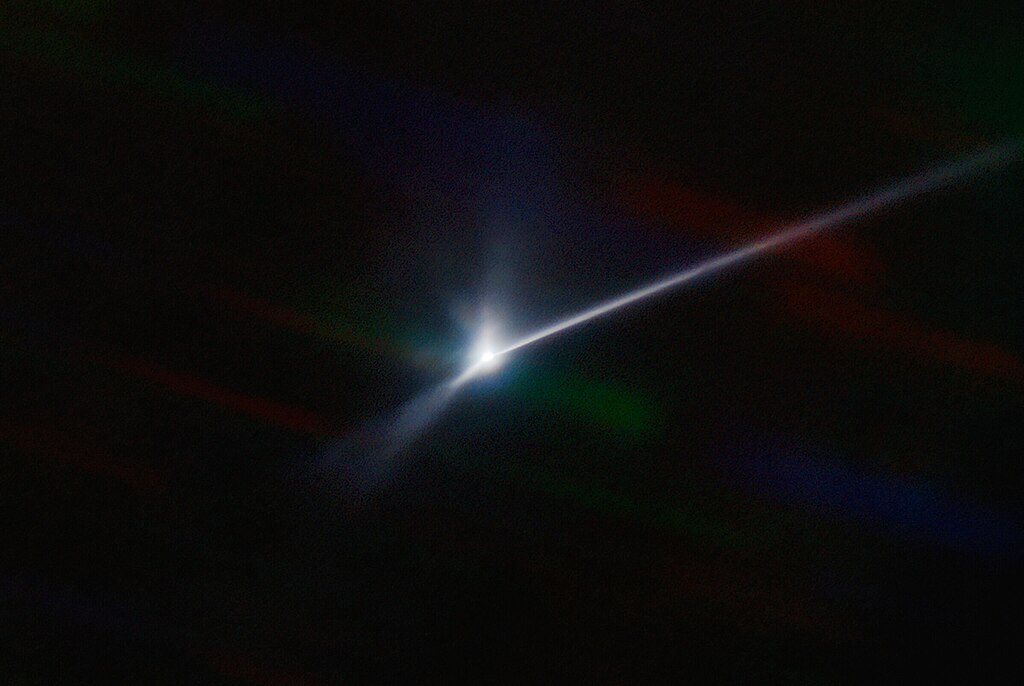Last September, NASA purposefully smashed a spacecraft into Dimorphos, a 160m-wide space rock orbiting a larger asteroid named Didymos. The goal of the mission, called DART (the Double Asteroid Redirection Test), was to demonstrate humanity’s ability to redirect hazardous asteroids away from Earth. That part of the mission was a success above and beyond all expectations. But now scientists are also learning more about the origins of the two asteroids. A study conducted in the wake of the DART impact found that Dimorphos is made from the same material as Didymos, and that the pair of asteroids likely originated from a single body.
The DART impact blasted a significant cloud of debris away from Dimorphos. The initial cloud, made of fine-grained dust and gaseous material containing traces of sodium and potassium, quickly spread out and moved away from the system. It dispersed within a matter of minutes. A second cloud of heavier debris, however, persisted for months. Using NASA’s 3m IRTF telescope in Hawaii, a research team observed this secondary debris cloud for a week following the impact, watching as it evolved and spread out. What they found was that the spectroscopic signature of the Dimorphos debris matched that of pre-impact Didymos.
Both asteroids, in other words, were made from the same material: silicate (a compound of silicon and oxygen).

Before the DART impact, only ~5 percent of the light from the system originated at Dimorphos. It was drastically outshined by its larger partner Didymos, making it incredibly difficult to get distinct spectral observations of the tiny asteroid. However, after the impact, the whole system brightened considerably, and the debris, at its maximum, contributed more than 64% of the light reaching Earth-based telescopes from the system. This bright glow made it possible to study the composition of Dimorphos’ debris cloud.
The research team noticed that the debris was made largely of heavier material and larger rocks, because the solar wind quickly pushed away the smaller grains. This appears to contrast with material on the surface of Didymos, which the researchers predict is made up of mostly small grains – a prediction that the upcoming European Space Agency’s HERA mission will be able to confirm.
So if Didymos and Dimorphos are made of the same material, how did they end up as separate asteroids?
The leading theory is called the ‘rotational-disruption’ model:
“Asteroids with diameters smaller than a few tens of km can disrupt as their fast rotation applies tension on their weak internal strength, resulting in ejected material that goes into orbit and eventually accumulates into a satellite,” the researchers explain.
As a small, fast-spinning asteroid, Didymos is a good candidate for this model. It has almost certainly ejected particulates into orbit around it. It also shares a geometry common among binary asteroids: spherical with a bulge around the equator. This geometry only strengthens the case for the rotational-disruption model.
With the new data collected after the DART impact, the case is pretty well closed. The fact that the spectral signature is identical between Didymos and Dimorphos strongly suggests that they originated as one body. Over time, the fast-spinning asteroid spun material out into orbit, which then collected together to form the tiny moon called Dimorphos. There it stayed for eons, until DART interrupted its path, and gave it a new orbit (and gave us a unique opportunity to study it).
Learn More:
Polishook et al. “Near-IR Spectral Observations of the Didymos System — Daily Evolution Before and After the DART Impact, Indicates Dimorphos Originated from Didymos.” ArXiv Preprint.
The post Dimorphos is Probably a Piece of Didymos appeared first on Universe Today.
No comments:
Post a Comment